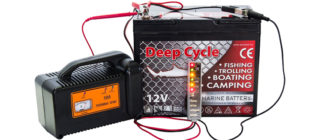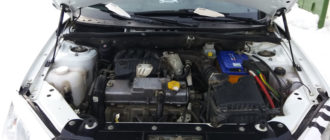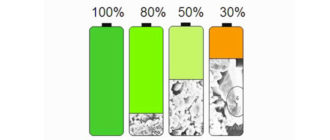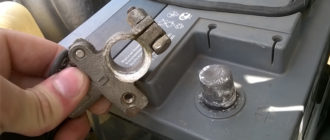Car batteries are operated in rather harsh conditions associated with large temperature differences, vibration, exposure to aggressive environments and other adverse factors. In this regard, they often have various malfunctions and problems. One of the problems often encountered with automotive batteries is the oxidation of their contact terminals.
Content
Causes of Battery Terminal Oxidation
Problems associated with poor contact are the most common cause of damage to any electrical equipment. The appearance of oxides on the battery terminals is harmful to the vehicle’s electrical equipment and may indicate a problem with the battery.
Small oxide on metal surfaces inevitably appears as a result of the interaction of their surface with atmospheric oxygen and other reagents. Therefore, even very high-quality electrical contact worsens over time due to natural oxidation processes. In addition, if the contacts are made of different metals, a galvanic potential difference arises between them, which also leads to premature surface oxidation.
With the appearance of additional aggressive factors or improper fixation of the terminals, conduction disturbances and contact area oxides can occur very quickly.
Excessive oxidation of the terminals of automotive batteries, as a rule, occurs for four reasons:
- aggressive effect in the event of leakage of electrolyte vapor from the case of a damaged battery (electrochemical corrosion) - such an oxide has a white color;
- poor contact at the junction of the battery terminals with the vehicle’s conductors due to poor tightening, increased humidity in the engine compartment and dirt entering the unsecured gap, which leads to sparking and burning of the contact area, leading to blackening;
- humidity in the engine compartment oxidizes the copper contained in the terminal - due to this appears a greenish coating and rust;
- the battery’s contact is made of lead, and the car’s wiring conductor is made of another metal (copper or brass), which leads to a chemical reaction between them - the color of the oxide can be greenish.
Oxides appearing for these reasons can appear on both electrodes of the battery. Due to the small design differences of these contacts, the frequency of their appearance on each electrode varies slightly.
Why is the positive terminal on the battery oxidized?
The positive terminal of most cars is closed with a plastic cover, which contributes to the accumulation of condensate under it. With poor battery tightness from exposure to high temperatures during engine operation, as well as with strong recharging, electrolyte vapor leaks. Particles of acid from these vapors eventually concentrate under the insulating cap in the area of the positive terminal and lead to its oxidation.
At the same time, due to the fact that the positive electrode is closed by a lid, fewer external contaminants get into the junction, which reduces the likelihood of poor contact, arcing and the associated blackening.
Thus, on the positive side, the appearance of white oxide associated with the leakage of electrolyte vapor is more likely.
Why is the negative battery terminal oxidized
The negative terminal of the battery is more susceptible to external influences because it does not have a protective cover.Because of this, acidic electrolyte vapors are less condensed on it, but more dust and dirt gets into it. All this leads to a faster deterioration of the electrical contact of the cathode of the battery with the wiring, the occurrence of small spark discharges during engine starts, which ultimately lead to burnout and blackening of the contact surface.
These problems most often occur when connecting the battery to the originally contaminated contacts and when they are loosened.
What can oxidize the terminals
Over time, the resistance at the site of oxidized contacts becomes so large that most of the battery current is lost on it, and the starter cannot spin. In this regard, it will be impossible to start the car engine.
The metal of the oxidized terminals becomes jagged, the contact surface area decreases, which worsens the conductivity even after they are cleaned and will contribute to the faster appearance of oxides during further operation. Therefore, it is necessary to regularly conduct a visual inspection of the battery terminals and carry out preventive measures related to eliminating bad contacts and deposits by cleaning them, as well as lubricating the terminals to protect them from oxidation.
If a whitish acid coating appears due to a violation of the integrity of the battery case, it is necessary to replace it. This is due to the fact that cracks in the battery case from vibrations and jolts during car operation will only increase over time, which will lead to the ingress of acid electrolyte into the engine compartment with dire consequences.
The appearance of a green coating on the contacts may indicate increased humidity in the parking lot of the car, which can lead to corrosion of its other metal parts.
How to identify signs of terminal oxidation
The oxidation of the contacts of the battery can be determined both by visual inspection, and by indirect signs associated with a decrease in the starting current on the car starter and a decrease in the brightness of light devices.
Visual inspection is associated with the search for microcracks, loose electrodes, traces of electrolyte leakage, and the presence of dirt on the vents. If you are sure that the battery is fully charged, but the engine is turning slightly by the starter, the cause may be poor contact with the battery.
In order to determine if a whitish coating is acidic, you need remove the battery from the car and, using protective gloves, rinse the contacts and the battery case with a weak solution of soda (up to 10%) in warm water, and then wipe it dry. If an alkaline solution gets on the acid, a reaction will occur, accompanied by hissing and heat.
How to clean battery terminals
The oxidized terminals can be cleaned mechanically - using a coarse, moist material, a small metal brush or a knife. This must be done by removing the battery from the car. In addition to cleaning, it is necessary to remove dirt from the surface of the battery and its technological ventilation openings, as it can interfere with the removal of gases and adversely affects the metal surface of the terminals. After that, the battery is installed in the engine compartment and the terminals are tightened in accordance with the force recommended by the manufacturer.
To get rid of the problems associated with the oxidation of the terminals, it is advisable to lubricate them with silicone grease or a special protective spray after tightening to reduce the influence of the external environment. You can use other lubricants, but they collect dirt on themselves. If after cleaning any of the terminals starts to oxidize again, it is necessary to check the serviceability of the battery case.









